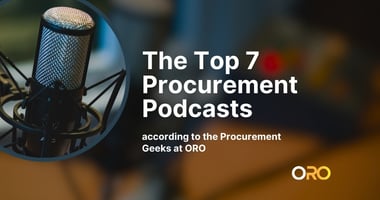In the fast-paced world of procurement and supply chain management, keeping up with the latest news...
AI-Powered Procurement Orchestration: Insights from the London Masterclass (April 2025)

Procurement Orchestration Masterclasses hosted in cities across the US and Europe have highlighted the urgent requirement for not only digital procurement transformation but, more importantly, for AI-driven, intelligent orchestration. Chief Procurement Officers and Digital Transformation leaders are looking to improve processes and user interactions with procurement while also redefining how procurement operates, engages, and drives business value.
Here are just a few of the insights shared by procurement leaders during the masterclasses hosted in London on April 2, 2025
Why Procurement Leaders Are Prioritizing AI-Powered Orchestration
Procurement orchestration addresses many of the most pressing challenges faced by global enterprises as they continue their digital procurement transformations. At the core, orchestration unifies an often fragmented landscape, creating a seamless experience for stakeholders both internally and externally, with a focus on:
- User Experience and Engagement: Creating easier ways of working, productivity, and a simpler, more intuitive user journey, orchestration ensures that procurement becomes a function that people love interacting with.
- Streamlining Processes: From onboarding suppliers to managing risks and tail spend, orchestration simplifies complex workflows, reducing redundancies, manual data entry, and inefficiencies.
- Creating a Unified Front Door: A single, cohesive entry point into procurement eliminates unnecessary confusion and enhances accessibility for users across the organization.
- Maximizing Existing Investments: Orchestration ensures the utilization of existing tools and technologies while introducing new functionality and access to innovation.
- Data Unification: Consolidating fragmented data sources improves quality, reduces duplication, and provides the visibility needed to make informed decisions.
- Buying Safely: Ensuring compliance checks are conducted and mitigating risks are critical outcomes of a well-orchestrated procurement process.
Ultimately, intelligent orchestration increases productivity and effectiveness, fosters meaningful engagement with the business, and delivers measurable ROI for procurement teams.
Why Now is the Time for AI-Driven Transformation
The urgency surrounding procurement orchestration stems from several pressures shaping today’s business environment, including outdated and fragmented technology, demand for visibility, reducing tail spend, and more.
- Fragmented Technology: Many organizations continue to struggle with outdated platforms and disconnected systems that deliver a poor user experience, hinder efficiency, and reduce collaboration.
- Demand for Efficiency and Visibility: Streamlined processes, better data quality, and improved analytics are essential for reducing costs and driving smarter decision-making, crucial for competitive enterprises.
- Investments in the Future: Organizations recognize that digitization is no longer optional – it is a requirement to remain competitive and to attract top talent in an evolving market.
- Addressing Tail Spend: Effective management of low-value purchases unlocks significant savings and reduces risk exposure.
- Connecting with the Business: Procurement must engage meaningfully with stakeholders by offering value-added services that align with broader business goals, driving value.
- Improving Adoption and Accessibility: Simplified processes and streamlined, AI-powered workflows encourage the adoption of procurement tools across the organization, ensuring that everyone benefits from orchestration efforts.
- Mergers and Acquisitions: In times of organizational change and transition, unifying systems through orchestration provides stability and scalability for future growth.
Leading Use Cases Driving Procurement Innovation
1. Procurement Front Door
Creating intuitive user journeys and improving the overall user experience ensures that procurement tools are accessible and engaging for all stakeholders. Through the delivery of a unified front door, establishing a single-entry point for procurement, processes gain a reduced degree of complexity.
2. Supplier Onboarding
For many enterprises, supplier onboarding continues to cause friction, with lengthy delays in onboarding reducing satisfaction and causing bottlenecks. Simplifying and heavily automating the onboarding process not only reduces timelines but also improves supplier performance management.
3. Leveraging Data Insights
Data collection and spend analytics were also highlighted as essential for driving informed decision-making, with orchestration enabling the consolidation of fragmented data sources, resulting in enhanced visibility and more accurate insights.
4. Automating Low-Value Tasks
Vital for freeing up procurement teams to focus on strategic initiatives and empowering users through self-service capabilities, the automation of routine tasks such as manual contracting and low-risk purchasing was shared as another high-priority use case.
5. Improving Ease of Procurement
Ultimately, participants stressed the need to make procurement interactions simpler and more intuitive for internal and external stakeholders alike.
The Path Forward
The ORO Labs Procurement Orchestration Masterclass in London highlighted that procurement intelligent orchestration isn’t just about solving today’s problems but also about building a foundation for long-term success. By addressing inefficiencies, unifying processes, and leveraging data effectively, procurement teams are transforming from reactive cost centers into proactive strategic partners that everyone loves to work with at their organizations.
If you’d like to connect with procurement leaders in your region for a half-day session focused on prioritizing use cases, navigating the procurement orchestration journey, and building a business case for deployment, join us at a meeting near you by registering via the link below.





